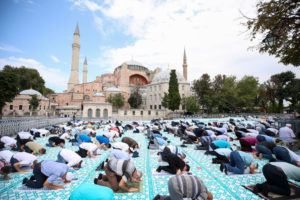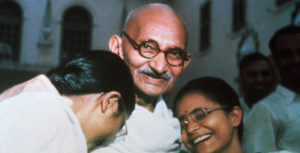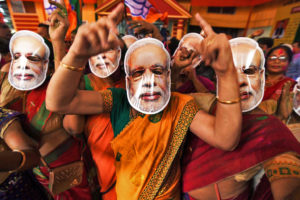India’s entry into the ranks of the world’s surviving theocracies — Iran, Afghanistan, the Vatican City — arrived bathetically. When the history of the nation’s descent from secularism to Hindu nationalism is written, it might end in Ayodhya. Just after noon yesterday, the Ram Temple was consecrated, a stone’s throw from the ruins of Babur’s Mosque, which was demolished three decades ago by a Hindu mob. The climax was supposed to be the moment an idol was placed in the sanctum sanctorum of the imposing pink sandstone construction — 75 years after a similar idol “magically” appeared in Babur’s Mosque, giving fodder to the feverish Hindu fantasy that the birthplace of Ram lies underneath its foundations.
Millions watched the spectacle. A 30-metre priapic incense stick made of 1,500kg of cow dung was lit for the occasion. Babies were prematurely induced so that they would be born on this holiest of days. Yet, for all the pomp, the pilgrims will doubtless be returning home disappointed. For the Ram Temple, which is supposed to be the third-largest in the world, isn’t even close to completion. Not even its first floor has been built: it is set to be inaugurated in December — too late for Narendra Modi, who is evidently a man in a terrific hurry. At the height of the pandemic, either conscious of his mortality or deliberately disregarding the convention of posthumous recognition, Modi had the Ahmedabad cricket stadium renamed after him. This time around, there’s an inconvenient event just around the corner: a spring general election.
And so, like the Italian umarell — the ubiquitous pensioners who have an inexplicable penchant for observing construction sites, and every so often proffering unwanted advice to workers — Modi’s fans have had to content themselves with what is essentially a work in progress. To the bhakts — diehards — of Modi’s Bharatiya Janata Party (BJP), there was the consolation prize of seeing their ruler lather mascara on the idol’s eyes.
Indian liberals, by contrast, observed the proceedings with obituarial gloom. To them, this is the end of an era. The curtain has fallen on secularism — on the grand vision of the country’s founding fathers. The Fifties and Sixties, so the story goes, were a golden age of religious peace; the Congress Party that had ruled uninterruptedly since independence in 1947, we are told, not only protected minorities from the worst instincts of the Hindu majority but also gave them considerable constitutional concessions. Muslims, for instance, were allowed to conserve such folksy and innocent practices as polygamy, unilateral divorce without alimony (a male prerogative only, of course), and discriminatory inheritance (sons being entitled to twice the share of daughters). The meddlesome state was kept at bay.
This arrangement was proof, apparently, of the genius of “Indian secularism”, which liberals saw as superior to French laïcité, with its unedifying principle of separating church and state. Such a severance would have resulted in monstrous godlessness, argued Indian liberals. Worse, the very idea stank of foreignness. Fortunately, though, India’s first prime minister, Jawaharlal Nehru, had no truck with such heresies. As the Nobel Laureate Amartya Sen has argued in The Argumentative Indian: he understood that only by making concessions to religion can religious passions be controlled.
The political theorist Rajeev Bhargava, doyen of Delhi’s liberal intellectual aristocracy, made a similar case. Nehru had cracked the formula. His secularism did not disregard Hinduism and Islam; rather, it maintained a “principled distance” between the two. Stanley Tambiah, anthropologist, also praised Nehru’s “large-hearted and genuinely accommodative” secularism, which — unlike laïcité — won over minorities. Or so he claimed.
Try telling that to the Muslims who actually lived through the Nehruvian period. For all his secularist bravura, Nehru scarcely lifted a finger to stop the massacre of Muslims in Hyderabad in 1948. Some 40,000 were killed, and another 13,000 imprisoned, as the kingdom was annexed to the republic. Further north, in Uttar Pradesh, Muslims were fired en masse from government after accusations that they were a fifth column in the pay of Pakistan. In the eastern borderlands, some 98,000 Indian Muslims were deported to East Pakistan. Meanwhile, influential Muslim leaders such as Sheikh Abdullah and Kasim Razvi were thrown in prison.
What’s more, the Congress Party singularly failed to tackle the scourge of interfaith riots — although “riots” doesn’t quite cut it. These were, in fact, pogroms. They claimed nearly 3,000 Muslim lives in the 10 years to 1963; at just under a tenth of the country’s population, they accounted for 82% of the fatalities in this era of violence. The following year, in the wake of the theft of the moi muqaddas — a strand of hair that once nestled in the Prophet Muhammad’s beard — a few thousand Muslims were slaughtered in and around India’s eastern rustbelt. Many responded by giving up on the nation altogether: around 800,000 — one in 50 Indian Muslims — left for Pakistan.
All this in the golden age of Indian secularism. Yet half a century on, liberals remain in denial, forever regurgitating the sophistry of the secularists. The unthinking celebration of Indian secularism was in fact wishful thinking disguised as wisdom. In recent years, scores of revisionist studies have shown, with good old-fashioned empiricism, how Indian secularism appeased violent Hindu nationalism. Sadly, these have been greeted with a deafening silence. Rather disingenuously, India’s liberals remain oblivious to the dangers of religious appeasement. Few recognise how, for instance, calls to introduce a ban on cow slaughter might alienate Muslims and low-caste Dalits, who see no reason to uphold the upper-caste Hindu injunction against consuming beef.
Such concessions to Hindu majoritarian sentiment have been the cause of much grief and interfaith tension. Not that secularist liberals — many of them card-carrying Congress members — were over-bothered by such unpleasantries through the second half of the 20th century, when the party was in power for all but nine years. Their attitudes began to change when the BJP, the Congress’s explicitly Hindu nationalist rival, came to power for the first time in 1996. Now that the Congress was in the opposition, it was fair game to fault Delhi’s rulers for failing to put a stop to Hindu violence against Muslims. The process accelerated under Modi in 2014 — the same Modi who as Chief Minister of Gujarat had been criminally negligent at best or complicit at worst in handling the riots of 2002, in which a thousand Muslims perished.
The liberal secularists, however, have been loath to admit that the Congress was just as nasty to minorities when it was in power as the BJP is today. In fact, the BJP did not come out of nowhere. Both parties have shared a pensée unique: a commitment to caste and class hierarchy, coupled with an allergy to redistribution, sustained electorally by roaring appeals to Hindu tradition. This was the worldview that produced a Congress that murmured secular pieties, claiming that its ranks were a “mirror of the nation”, even though in the Thirties and Forties Muslims accounted for a mere 2 to 3% of its total membership — while making up 25% of India’s population.
In the provinces the Congress controlled, idol worship was forced down the throats of hapless Muslim students. Discriminatory licensing policies destroyed Muslim businesses. Cow slaughter bans bankrupted Muslim butchers. History textbooks were rewritten to heroise Hindus and malign Muslims. And so the path to Partition was laid. But no lessons were learnt. Indeed, scarcely any attempt was made at course correction after 1947. Very simply, the Congress needed religious appeals to win elections. This was true in the late-19th century: when devolution and the extension of the franchise to the middling sort proved a challenge, religion had come to the rescue, with Congress leaders wrapping themselves in the saffron flag of Hinduism. And it was true in the mid-20th century as well. In the absence of redistribution and land reform, Hinduism was the glue that held the orders together. Election campaigns began in temples. Religious festivals became indistinguishable from political rallies.
Still, before the century was out, it had become clear that the Congress was a spent force. Poor economic growth rates had steadily discredited it; staggering corruption in the Eighties and Nineties ultimately did for it. But the BJP was able to steal a march on the Congress not because it was radically different but because it was essentially the same — only less inhibited and more articulate in its majoritarianism. Indian secularism was the first step on a slippery slope to Hindu nationalism. We can now see that the Congress Party was simply BJP lite.
The modern history of Ayodhya illustrates this point rather well. When the idol of Ram magically appeared overnight at Babur’s Mosque in 1949, no doubt through the agency of local delinquents, the Congress took a rather indulgent view of the whole affair. The mosque was boarded up and the idol left inside, giving oxygen to Hindu zealots. In 1985, their demands that the locks be opened were answered by the Congress, whose leader cynically launched his election campaign four years later at the site, amid raucous calls for Hindu renewal. But it was the BJP that proved more adept at that game, demolishing the mosque completely in 1992. Predictably, riots ensued across the country, and the BJP rode to power four years later off the back of religious polarisation.
By 2010, Hindu nationalists enjoyed a comfortable presence in all walks of life. That year, the Allahabad High Court pronounced Muslims “junior partners” in national life, dividing Babur’s Mosque into three tracts and pledging two to Hindus. Then, 10 years later, with the BJP once again in power, the Supreme Court handed the entire plot to Hindus, to construct a temple on the ruins of the 16th-century mosque. Now, with the consecration of the Ram Temple, and by extension the effective inauguration of a new theocratic regime, I suspect we have finally heard the last about that spurious, self-congratulatory declension of laïcité that was Indian secularism. Perhaps it is time liberals defended the real thing.
Disclaimer
Some of the posts we share are controversial and we do not necessarily agree with them in the whole extend. Sometimes we agree with the content or part of it but we do not agree with the narration or language. Nevertheless we find them somehow interesting, valuable and/or informative or we share them, because we strongly believe in freedom of speech, free press and journalism. We strongly encourage you to have a critical approach to all the content, do your own research and analysis to build your own opinion.
We would be glad to have your feedback.
Source: UnHerd Read the original article here: https://unherd.com/




